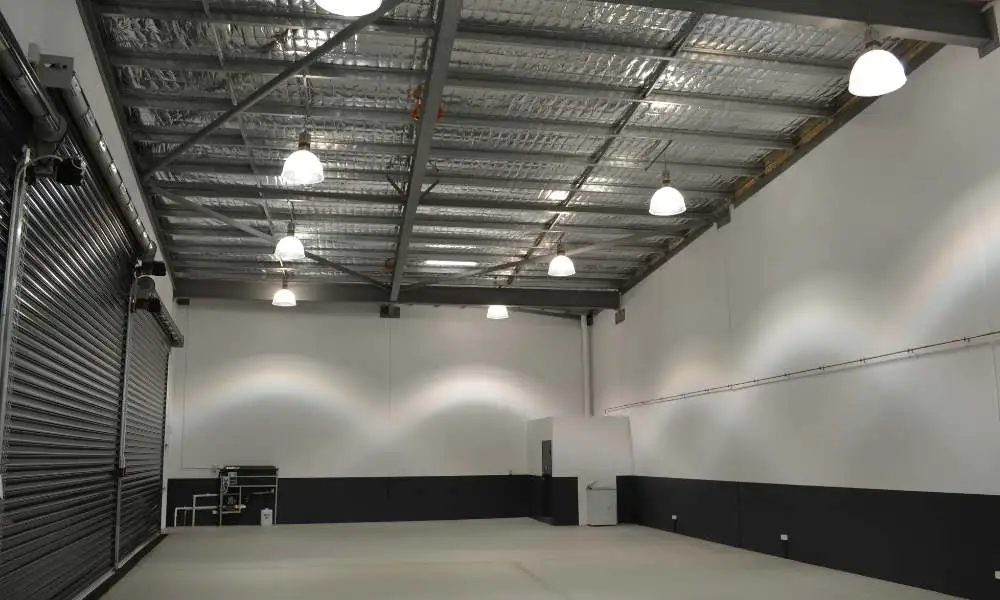Warehouse lighting has come a long way in recent years, evolving from traditional fluorescent fixtures to cutting-edge, energy-efficient solutions.
The right lighting brightens the space and significantly impacts productivity, safety, and energy costs. This article explores how innovative warehouse lighting solutions transform the industry, making warehouses more efficient and environmentally friendly.

1. The Evolution of Warehouse Lighting
Warehouses have traditionally relied on fluorescent tube lights to illuminate their expansive spaces. While these lights served their purpose, they came with their fair share of limitations.
They consumed substantial energy, required frequent replacements, and often left dark corners in the facility. However, with advances in LED warehouse lights, warehouses now have access to various innovative solutions that address these shortcomings.
2. LED Lighting: A Game-Changer
One of the most significant innovations in warehouse lighting is the widespread adoption of LED (Light Emitting Diode) technology. LEDs have transformed how warehouses are lit, offering substantial energy savings and longevity.
LED warehouse lights consume significantly less energy than traditional fluorescent lights, lowering electricity bills. Moreover, LEDs have a longer lifespan, reducing the maintenance costs associated with frequent bulb replacements.
3. Smart Lighting Systems
The integration of smart lighting systems into warehouse facilities is another remarkable innovation. These systems use sensors and controls to adjust lighting levels based on occupancy and natural light conditions.
When no workers are in a particular area, the lights dim or turn off automatically, saving energy. Smart lighting systems help warehouses reduce their carbon footprint and cut operational expenses.
4. High Bay Lights: Optimizing Vertical Space
High bay lights are specially designed for warehouses with high ceilings. These lights are mounted at elevated heights, making them ideal for illuminating vertical space.
High bay lights brighten the entire warehouse by efficiently utilizing vertical space and help optimize storage capacity. This innovation is a prime example of how warehouse lighting can be tailored to meet the space’s unique needs.
Also Read: Top 7 Fast Facts About LED Lightning
5. Natural Light Integration
Innovative warehouse lighting isn’t limited to artificial sources alone. Warehouses are now increasingly incorporating natural light through skylights and large windows.
Natural light reduces the need for artificial lighting during the day and creates a more pleasant and productive working environment for employees. It’s a sustainable and cost-effective way to brighten up your warehouse.
6. Motion Sensor Technology
Motion sensor technology has become a vital component of modern warehouse lighting systems. By detecting movement, motion sensors ensure that lights are only active when needed.
When a worker enters a particular area, the lights automatically turn on, and after a period of inactivity, they switch off. This technology not only conserves energy but also enhances safety within the facility by ensuring well-lit spaces where and when required.
7. Color Temperature Control
Innovative lighting solutions allow warehouses to adjust the color temperature of their lighting. You can choose between warm and cool white lighting based on your specific needs.
For instance, cool white lighting can be used in areas where precise color recognition is essential. In contrast, warm white lighting can create a more comfortable and inviting atmosphere in break rooms or offices within the warehouse.
8. Energy Efficiency and Environmental Impact
The adoption of innovative warehouse lighting is not just about brightening up the space; it’s also a significant step towards environmental sustainability.
LED lights, smart systems, and motion sensors collectively reduce energy consumption, which leads to lower carbon emissions and a reduced environmental impact. As businesses increasingly prioritize sustainability, these innovations align with their eco-friendly goals.
Also Read: Choosing the right lighting starts with accurate calculations. Use a reliable lumens to kelvin calculator to determine the ideal color temperature for your warehouse needs.
9. Improved Employee Wellbeing
Warehouse lighting innovations aren’t just about the physical space; they also positively affect the well-being of the people who work in these facilities. Proper lighting can reduce eye strain, prevent accidents, and create a more comfortable work environment. This, in turn, boosts employee morale and productivity.
10. Return on Investment (ROI)
Investing in innovative warehouse lighting may require an upfront cost, but it offers a remarkable return on investment. The energy savings, reduced maintenance costs, and improved efficiency contribute to long-term savings and make the initial investment worthwhile.
Conclusion
Innovative warehouse lights have revolutionized the way warehouses operate. From the widespread adoption of LED lighting to integrating smart systems, these innovations have made warehouses more energy-efficient, environmentally friendly, and safer.
They not only brighten up the space but also brighten the future of warehousing, offering a glimpse into how technology can drive progress and sustainability in a crucial sector of the economy. As the demand for efficient and eco-friendly warehouses continues to grow, investing in these lighting innovations is not just a choice but a necessity for businesses that want to stay competitive and reduce their environmental footprint in today’s world.